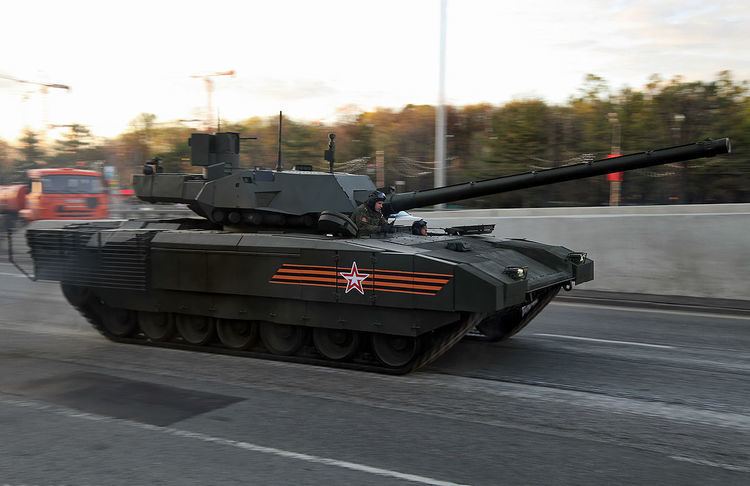 | ||
Type Tracked Heavy Armored Vehicle Designer Ural Design Bureau of Transport Machine-Building, Uralvagonzavod | ||
The "Armata" Universal Combat Platform (Russian: Армата) is a Russian prototype of an advanced next generation heavy military tracked vehicle platform. The Armata platform is the basis of the T-14 (a main battle tank, MBT), the T-15 (a heavy infantry fighting vehicle), a combat engineering vehicle, an armoured recovery vehicle, a heavy armoured personnel carrier, a tank support combat vehicle and several types of self-propelled artillery, including the 2S35 Koalitsiya-SV under the same codename based on the same chassis. It is also intended to serve as the basis for artillery, air defense, and NBC defense systems. The new "Armata" tank platform is meant to replace the older Russian MBTs and APCs that are currently used by the Russian military.
Contents
If the systems on the Armata are reliably reported, the tank surpasses comparable NATO technology by a generation at least.
Origin of designation
The combat platform is formally designated as "prospective family of heavy unified battlefield platforms". The name "Armata" derives from the plural of the Latin word arma which refers to weapons of war, and was an old Russian word for 14th century guns; it is also the plural of the modern Greek word "Arma", meaning "chariot". This was wrongly transcribed as "Armada" by journalists on several occasions.
Development
The Armata combat platform has been under design and development since 2009 by Uralvagonzavod headquartered in Nizhny Tagil. Prototypes of heavy armored vehicles based on the Armata combat platform were presented at the defense exhibition Russian Arms Expo in Nizhny Tagil in September 2013. In November 2014 trials of the 2S35 Koalitsiya-SV self-propelled gun variant were under way.
The first vehicles of were shown to the public in the 2015 Moscow Victory Day Parade, with a batch of 32 to be delivered to the Russian Land Forces during the same year. Russian media has previously stated that mass delivery will start in 2015 or 2016.
A total of 2,300 MBTs are expected to be supplied by 2020, modernizing 70 percent of the Russian tank fleet. The Uralvagonzavod plant is expected to roll out around 500 T-14 Armata tanks per year. At a 2015 Moscow Victory Day Parade practice drill run on the Alabino training grounds several types of armored vehicles described as various Armata models appeared with their turrets covered. Russian Defence Ministry signed a long-term contract for delivery of tanks and heavy IFVs on the Armata basis.
Serial production of the Armata Platform's ceramic armor components began in mid-2015.
Design
Russian Lieutenant-General Yuri Kovalenko states that the "Armata" combat platform will utilize many features of the T-95 tank, of which only a few prototypes have been built. In the main battle tank variant, the ammunition compartment will be separate from the crew, increasing operational safety while the engine will be more powerful and the armor, main gun and autoloader will be improved.
According to preliminary reports, the new tank designated T-14 will be less radical and ambitious than the canceled ‘Object 195’ or T-95. It will weigh less, therefore being more agile and more affordable when compared to its more ambitious predecessors. Additionally, the T-15, Kurganets-25 IFV and Bumerang IFV will be able to equip the same 30mm Epoch Remote Control Turret.
The tank will have an unmanned, remotely controlled turret. It will be digitally controlled by a crew-member located in a separate compartment. It is believed that this would eventually lead to the development of a fully robotic tank.
Vehicles of the Armata platform will be equipped with the radar and other technologies found on the Sukhoi T-50 fifth-generation jet fighter. They include a Ka band radar (26.5–40 GHz) based on AESA radar. The devices should be ready by 2015.
The Armata will use a new type of lightweight armor designated 44S-SV-SH, developed by Steel Scientific Research Institute enterprise. This armor does not lose its qualities when used in extremely low temperatures, which may indicate an interest in using the tank in Arctic conditions.
The Armata tank will have a remote weapon station turret and an automated control system, with the crew protected by an armored capsule. It will have an externally mounted 125 mm gun with 32 rounds of ammunition; in addition to tank rounds, a new laser-guided missile able to be fired from the main gun with a tandem Kornet-D (or better) anti-tank or anti low flying helicopters warhead with a range of 7,000–12,000 m (23,000–39,000 ft). The secondary armament will consist of a 30 mm cannon and a 12.7 mm machine gun.
